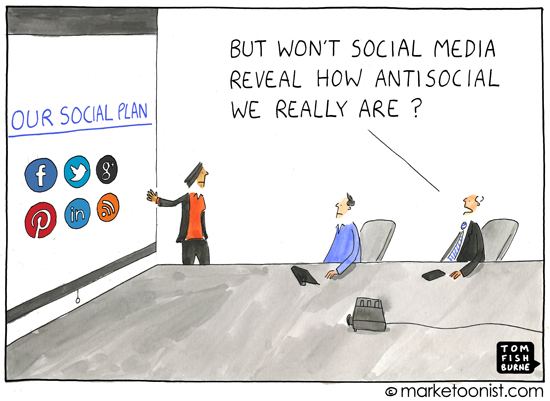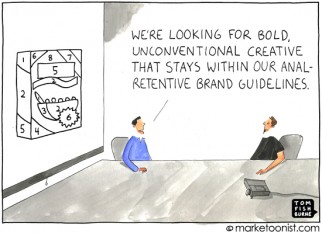Brands are historically hardwired to communicate in one direction. Ever since P&G invented brand management in the 1930’s, brands have been designed to hammer home their single-minded propositions as efficiently as possible.
The first steps into social media can be tricky for brands, because they have to put down the megaphone and engage in conversations. Unlike a 30-second spot, we can’t control consumer conversations to be “on brand”. This can be difficult particularly when conversations turn negative.
One of my favorite social media examples this year came from UK Tampon brand Bodyform. In October, Bodyform was criticized in a humorous way by a Facebook user for “lying” in their advertising about what happens to women when they get their period. The comment received over 100,000 likes and over 4,500 comments.
Many brands might have ignored the conversation and waited for it to go away. Bodyform took a different tack and responded directly to the Facebook user with a very funny video mock-apology.
Bodyform brand controller Yulia Kretova described the response. Their social mindset is relevant to any brand trying to be successful in social media:
“We found Richard’s post very amusing and wanted to continue the positive dialogue around periods that this generated. Working with the brand for 5 years breaking down the taboo around Bodyform and periods has always been a challenge and I hope that we have started to address this. Carat has created an original and uniquely personalised response, brilliantly PR-ed by Myriad, allowing Bodyform to quickly engage in consumer conversations in a meaningful way.”
Bodyform listened, responded quickly, and enabled a conversation without trying to dominate it with brand features and benefits. Social media can’t suddenly make an antisocial brand social. The social mindset has to come first.
(Marketoonist Monday: I’m giving away one signed print of this week’s cartoon. Just share an insightful comment to this week’s post by 5:00 PST on Monday. I’ll pick one comment. Thanks!)



Tessa Stuart says
Large companies with “control and command on message at all times” mind sets find the increasing power of the consumer on social media challenging. They cannot control or ignore the publicly shareable commentary now happening. innocent drinks saw early that social media is a way of sharing other messages about the organisation than just product details, that it is a means to connect and delight and amuse and THANK those supporters – yes, supporters! – who buy you. And in doing so, to turn commerce into connection. And when you have no marketing budget for your first five years (as innocent didn’t), social media is free, fun, immediate, creative, interactive, spontaneous, responsive and a whole new way of doing business and charity – knitted hats on smoothies for charity AgeUK.
DSprogis says
My guess is that people are beginning to resent the intrusion of advertising into their social media lives. The Facebook-WalMart experiment is interesting to watch but I doubt the data will be interpreted fairly. My guess is that the data suggests users are actively avoiding ads, commenting that it’s annoying and it will push some Facebook users off the network. But those that want it to success will find evidence to support it. In the end, Facebook shareholders want their returns so the company has to start monetizing. Let’s hope they’re smart about it.
Bill Carlson says
Happened to see this today, supports some of DSprogis’ thinking — http://leaderswest.com/2012/12/14/people-dont-like-social-media-marketing/
Can’t help wondering which was more beneficial to the brand — the social media exchange itself or the ensuing publicity (like this article)?
Ted L. Simon (@tedlsimon) says
Tom,
You lied to us. You provided a headline that led me first to believe that I would become enlightened on the secret to creating a social plan for our brands.
Instead, you provided a refreshing, entertaining real world example that drives home this point: the 2-way relationship in the social channel is very different than the 1-way path of older marketing/communication channels. That difference requires a different marketing mindset and approach to this channel, both strategically and executionally.
You lied to us, Tom. And, in doing so, you exceeded my expectations (as usual). Bravo! Great post. Keep it up!
P.S. Love the Bodyform video. Brilliant!
Nik says
Keeping consumer conversations “on brand” is challenging even for brands with an established social presence. I just read an example this morning about Starbucks sponsorship in the UK with The Natural History Museum. Live tweets with the appropriate hashtag were published on a big screen in the museum ice rink. Unfortunate for them the tweets were not filtered. The live conversation became focused on Starbucks tax payments issues in the UK and curse words were displayed on the big screen.
The bottom line, as mentioned above, Social Media has changed the rules of the game and marketing needs to adapt.
Allen Roberts says
Hi Tom, Thanks for assembling this story, and cartooning it in a few words and lines.
Love your posts, cartoons, and the material you present, Thanks. Merry Christmas.
Allen
Frank Corley says
Large very public companies have the basic fact that no matter what message they present they will always have negative shots taken at them. So when they jump into an open forum a message with all good intentions will get hammered to some degree.
For those firms it seem the more you can control your target audience the more positive the outcome.
Mariam Durrani says
Its a medium to communicate and help generate word of mouth. Companies get caught up in the looks, aesthetics, langugage etc. of the social sites so much that they sometimes forget sheer objective of social media is to land brands in everyday conversations and motivate action.
Charles Edwards says
Nik, love it.
Perhaps even worse, check out the ‘epic fail’ of the Australian Airline QANTAS.
“The timing of the PR exercise was questionable, coming just a day after Qantas and its unions broke off contract negotiations and after Qantas grounded its fleet in late October, a drastic move that stranded thousands of angry customers”
I wasn’t one of those customers, but would query the marketing strategy of an airline that was prepared to shut down its entire international operations in an attempt to force a solution on a union in what was a domestic (Australian) market dispute only.
No amount of marketing is going to fix that kind of problem, of an airline that just didn’t care about its customers. A lot of grovelling perhaps, but not just marketing pap.
I’m Australian, and its that kind of attitude of QANTAS towards its customers that makes me fly with just about anyone else.
tomfishburne says
Hi all,
Great commentary, thanks! This week’s cartoon print goes to Tessa for illustrating the mindset that thrives in social media…
-Tom
Tessa Stuart says
Dear Tom,
Thank you very much. I will treasure it.
I do think that because of companies like innocent drinks’ success in originating and owning a particular tone of voice and personality, it has become much harder for organisations to find their own. Many resort to lazy copying of a “chummy” tone without really taking the trouble to find their own voice or their own topics. Look at Condescending Corporate Brand page on Facebook for the very fine examples of this that they collect and display. Or indeed Twitter in the UK today, the first day of 2013, when every food brand is tweeting: “And how will you be healthier in 2013?” To which the only real rejoinder is “That’s nobody’s business but my own, thank you.”
Ozan Sakin says
Hey, great cartoon as always. I’m a big fan. Just a side note: Couldn’t understand whether the use of “old Twitter logo” on the board is intentional or not? ..as if to suggest, even the client guy who presents the social media plan doesn’t have a clue where Twitter stands 🙂